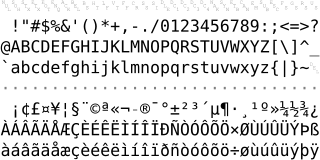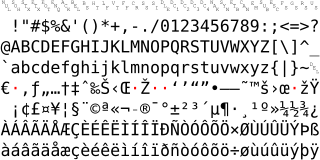Related Research Articles

Character encoding is the process of assigning numbers to graphical characters, especially the written characters of human language, allowing them to be stored, transmitted, and transformed using digital computers. The numerical values that make up a character encoding are known as "code points" and collectively comprise a "code space", a "code page", or a "character map".
Extended Binary Coded Decimal Interchange Code is an eight-bit character encoding used mainly on IBM mainframe and IBM midrange computer operating systems. It descended from the code used with punched cards and the corresponding six-bit binary-coded decimal code used with most of IBM's computer peripherals of the late 1950s and early 1960s. It is supported by various non-IBM platforms, such as Fujitsu-Siemens' BS2000/OSD, OS-IV, MSP, and MSP-EX, the SDS Sigma series, Unisys VS/9, Unisys MCP and ICL VME.

ISO/IEC 8859-1:1998, Information technology — 8-bit single-byte coded graphic character sets — Part 1: Latin alphabet No. 1, is part of the ISO/IEC 8859 series of ASCII-based standard character encodings, first edition published in 1987. ISO/IEC 8859-1 encodes what it refers to as "Latin alphabet no. 1", consisting of 191 characters from the Latin script. This character-encoding scheme is used throughout the Americas, Western Europe, Oceania, and much of Africa. It is the basis for some popular 8-bit character sets and the first two blocks of characters in Unicode.
ISO/IEC 8859-3:1999, Information technology — 8-bit single-byte coded graphic character sets — Part 3: Latin alphabet No. 3, is part of the ISO/IEC 8859 series of ASCII-based standard character encodings, first edition published in 1988. It is informally referred to as Latin-3 or South European. It was designed to cover Turkish, Maltese and Esperanto, though the introduction of ISO/IEC 8859-9 superseded it for Turkish. The encoding was popular for users of Esperanto, but fell out of use as application support for Unicode became more common.
In computing, a code page is a character encoding and as such it is a specific association of a set of printable characters and control characters with unique numbers. Typically each number represents the binary value in a single byte.

Windows-1252 or CP-1252 is a single-byte character encoding of the Latin alphabet that was used by default in Microsoft Windows for English and many Romance and Germanic languages including Spanish, Portuguese, French, and German. This character-encoding scheme is used throughout the Americas, Western Europe, Oceania, and much of Africa. All modern operating systems, including Windows, now use Unicode code points and text encodings by default, which are portable across all of the world's major languages.
ISO/IEC 8859-11:2001, Information technology — 8-bit single-byte coded graphic character sets — Part 11: Latin/Thai alphabet, is part of the ISO/IEC 8859 series of ASCII-based standard character encodings, first edition published in 2001. It is informally referred to as Latin/Thai. It is nearly identical to the national Thai standard TIS-620 (1990). The sole difference is that ISO/IEC 8859-11 allocates non-breaking space to code 0xA0, while TIS-620 leaves it undefined.
ISO/IEC 8859-8, Information technology — 8-bit single-byte coded graphic character sets — Part 8: Latin/Hebrew alphabet, is part of the ISO/IEC 8859 series of ASCII-based standard character encodings. ISO/IEC 8859-8:1999 from 1999 represents its second and current revision, preceded by the first edition ISO/IEC 8859-8:1988 in 1988. It is informally referred to as Latin/Hebrew. ISO/IEC 8859-8 covers all the Hebrew letters, but no Hebrew vowel signs. IBM assigned code page 916 to it. This character set was also adopted by Israeli Standard SI1311:2002, with some extensions.
ISO/IEC 8859-4:1998, Information technology — 8-bit single-byte coded graphic character sets — Part 4: Latin alphabet No. 4, is part of the ISO/IEC 8859 series of ASCII-based standard character encodings, first edition published in 1988. It is informally referred to as Latin-4 or North European. It was designed to cover Estonian, Latvian, Lithuanian, Greenlandic, and Sámi. It has been largely superseded by ISO/IEC 8859-10 and Unicode. Microsoft has assigned code page 28594 a.k.a. Windows-28594 to ISO-8859-4 in Windows. IBM has assigned code page 914 to ISO 8859-4.
ISO/IEC 8859-7:2003, Information technology — 8-bit single-byte coded graphic character sets — Part 7: Latin/Greek alphabet, is part of the ISO/IEC 8859 series of ASCII-based standard character encodings, first edition published in 1987. It is informally referred to as Latin/Greek. It was designed to cover the modern Greek language. The original 1987 version of the standard had the same character assignments as the Greek national standard ELOT 928, published in 1986. The table in this article shows the updated 2003 version which adds three characters. Microsoft has assigned code page 28597 a.k.a. Windows-28597 to ISO-8859-7 in Windows. IBM has assigned code page 813 to ISO 8859-7. (IBM CCSID 813 is the original encoding. CCSID 4909 adds the euro sign. CCSID 9005 further adds the drachma sign and ypogegrammeni.)
ISO/IEC 8859-9:1999, Information technology — 8-bit single-byte coded graphic character sets — Part 9: Latin alphabet No. 5, is part of the ISO/IEC 8859 series of ASCII-based standard character encodings, first edition published in 1989. It is designated ECMA-128 by Ecma International and TS 5881 as a Turkish standard. It is informally referred to as Latin-5 or Turkish. It was designed to cover the Turkish language, designed as being of more use than the ISO/IEC 8859-3 encoding. It is identical to ISO/IEC 8859-1 except for the replacement of six Icelandic characters with characters unique to the Turkish alphabet. And the uppercase of i is İ; the lowercase of I is ı.
Windows-1250 is a code page used under Microsoft Windows to represent texts in Central European and Eastern European languages that use the Latin script. It is primarily used by Czech, though Czech has now moved to UTF-8 and mostly abandoned this legacy encoding. It is also used for Polish, Slovak, Hungarian, Slovene, Serbo-Croatian, Romanian, Rotokas and Albanian. It may also be used with the German language, though it's missing uppercase ẞ. German-language texts encoded with Windows-1250 and Windows-1252 are identical.
Windows code page 1253, commonly known by its IANA-registered name Windows-1253 or abbreviated as cp1253, is a Microsoft Windows code page used to write modern Greek. It is not capable of supporting the older polytonic Greek.
Windows-1254 is a code page used under Microsoft Windows, to write Turkish that it was designed for. Characters with codepoints A0 through FF are compatible with ISO 8859-9, but the CR range, which is reserved for C1 control codes in ISO 8859, is instead used for additional characters. It is similar to ISO/IEC 8859-1 except for the replacement of six Icelandic characters with characters unique to the Turkish alphabet.
Windows-1257 is an 8-bit, single-byte extended ASCII code page used to support the Estonian, Latvian and Lithuanian languages under Microsoft Windows. In Lithuania, it is standardised as LST 1590-3, alongside a modified variant named LST 1590-4.
Code page 852 is a code page used under DOS to write Central European languages that use Latin script.
Several 8-bit character sets (encodings) were designed for binary representation of common Western European languages, which use the Latin alphabet, a few additional letters and ones with precomposed diacritics, some punctuation, and various symbols. These character sets also happen to support many other languages such as Malay, Swahili, and Classical Latin.
Windows code pages are sets of characters or code pages used in Microsoft Windows from the 1980s and 1990s. Windows code pages were gradually superseded when Unicode was implemented in Windows, although they are still supported both within Windows and other platforms, and still apply when Alt code shortcuts are used.

IBM code page 949 (IBM-949) is a character encoding which has been used by IBM to represent Korean language text on computers. It is a variable-width encoding which represents the characters from the Wansung code defined by the South Korean standard KS X 1001 in a format compatible with EUC-KR, but adds IBM extensions for additional hanja, additional precomposed Hangul syllables, and user-defined characters.
Code page 922 is a code page used under IBM AIX and DOS to write the Estonian language. It is an extension and modification of ISO/IEC 8859-1, where the letters Ð/ð and Þ/þ used for Icelandic are replaced by the letters Š/š and Ž/ž respectively. This matches the encoding of these letters in Windows-1257 and ISO/IEC 8859-13.
References
- 1 2 IANA Character Sets
- ↑ Stephens, David (2011), "Lost in Translation 1 - EBCDIC Code Pages", LongEx Mainframe Quarterly, Longpela Expertise
- 1 2 "Code page identifiers—CPGID 1047". IBM. Archived from the original on 2015-06-07.
This code page is meant for limited use to meet specific requirements. It is not intended as a replacement for Code Page 00037 which is the required code page for the United States and several other countries or Code Page 00500
- 1 2 "Coded character set identifiers—CCSID 37". IBM. Archived from the original on 2014-11-29.
- 1 2 3 "Coded character set identifiers—CCSID 500". IBM. Archived from the original on 2014-12-01.
- ↑ "Mappings | Vendors | Microsoft | EBCDIC". Unicode Consortium.
- ↑ "codecs — Codec registry and base classes § Standard Encodings". Python Documentation. Python Software Foundation.
- 1 2 3 4 5 "Chapter 5. 3270 Display Station and Printer Code Page Charts" (PDF). 3174 Establishment Controller Character Set Reference (3rd ed.). IBM. 1990 [1988]. GA27-3831-02.
- ↑ "Coded character set identifiers—CCSID 8229". IBM. Archived from the original on 2014-11-29.
- 1 2 3 "iso8859.txt". Kermit project / Columbia University.
- ↑ Code Page CPGID 00037 (pdf) (PDF), IBM
- ↑ Code Page CPGID 00037 (txt), IBM
- 1 2 3 IBM (2018) [1990, 1995]. "Character Data Representation Architecture (CDRA)". IBM . p. 327.
Prior to 1986, ISO-8 X'9F' (APC) mapped to EBCDIC X'E1'. This control code point is a graphic code point. It was previously used as numeric space character in many EBCDIC SBCS coded character sets, and with the latest revised CECPs, the numeric space character has been replaced with DIVISION SYMBOL.
- 1 2 3 "Code Pages (§ Version 1 vs Version 0)" (PDF). IPDS and SCS Technical Reference. IBM. p. 375. S544-5312-07.
- 1 2 "Coded character set identifiers—CCSID 12325". IBM. Archived from the original on 2016-03-27.
CP 1070 is CP 0037 Version 0
- 1 2 Code Page CPGID 01070 (txt), IBM
- ↑ Code Page CPGID 01070 (pdf) (PDF), IBM
- 1 2 Umamaheswaran, V.S. (2002-04-16). "UTF-EBCDIC". Unicode Consortium. Unicode Technical Report #16.
The map preserves the invariance for a set of 82 graphic characters (including SPACE) (known as the IBM Syntactic Graphic Character set), and maintains consistency with the IBM MVS Open Systems Code page (CPGID 1047) for the variant characters from within the ASCII repertoire.
- ↑ "ibm-1047". International Components for Unicode. Converter Explorer. Unicode Consortium.
- ↑ "Code page 1047" (PDF). IBM. Archived (PDF) from the original on 2015-07-08. Retrieved 2021-06-09.
- 1 2 3 4 xlate - Transliterate Contents of Records, IBM Corporation, 2010 [1986], archived from the original on 2019-06-16, retrieved 2016-10-18
- ↑ "x3270 Character Set". x3270 Documentation. Archived from the original on 2018-11-10.
- ↑ "ibm-500". International Components for Unicode. Converter Explorer. Unicode Consortium.
- ↑ "Code page 500" (PDF). IBM. Archived (PDF) from the original on 2015-07-08. Retrieved 2021-06-09.
- ↑ "ibm-273". International Components for Unicode. Converter Explorer. Unicode Consortium.
- ↑ "ibm-1140". International Components for Unicode. Converter Explorer. Unicode Consortium.
- ↑ "Code page 1140" (PDF). IBM. Archived (PDF) from the original on 2015-07-08. Retrieved 2021-06-09.
- ↑ "ibm-1140". International Components for Unicode. Converter Explorer. Unicode Consortium.
- ↑ "Code page 1148" (PDF). IBM. Archived (PDF) from the original on 2015-07-08. Retrieved 2021-06-09.
- ↑ "ibm-1141". International Components for Unicode. Converter Explorer. Unicode Consortium.
- ↑ "Code page 924" (PDF). IBM. Archived (PDF) from the original on 2015-07-08. Retrieved 2021-06-09.